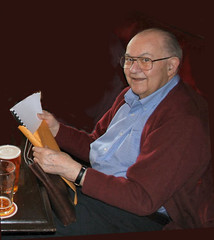
About UsThe Numismatic Bibliomania Society is a non-profit organization promoting numismatic literature. For more information please see our web site at coinbooks.org SubscriptionsThose wishing to become new E-Sylum subscribers (or wishing to Unsubscribe) can go to the following web page link MembershipThere is a membership application available on the web site Membership Application To join, print the application and return it with your check to the address printed on the application. Membership is only $15 to addresses in the U.S., $20 for First Class mail, and $25 elsewhere. For those without web access, write to: David M. Sundman, Secretary/TreasurerNumismatic Bibliomania
Society AsylumFor Asylum mailing address changes and other membership questions, contact David at this email address: dsundman@LittletonCoin.com SubmissionsTo submit items for publication in The E-Sylum, just Reply to this message, or write to the Editor at this address: whomren@coinlibrary.com
BUY THE BOOK BEFORE THE COINYou won't regret it! |
- WAYNE'S WORDS: THE E-SYLUM MAY 29, 2011
- REMINDER: KOLBE & FANNING 121ST SALE ENDS THURSDAY, JUNE 2, 2011
- NUMISMATIST ARTICLE HIGHLIGHTS NBS LIBRARY DONATIONS
- THE NUMISMATIST AVAILABLE IN IPHONE/IPAD APPS
- CENTRAL STATES CREATES FUND FOR GRANTS TO NUMISMATIC AUTHORS
- ERIC NEWMAN PRESENTED WITH GOLD MEDAL HONORING HIS 100TH YEAR
- NUMISMATISTS SHOWER CENTARIAN ERIC NEWMAN WITH BIRTHDAY WISHES
- THE ONE-HUNDRED-YEAR-OLD NUMISMATISTS CLUB
- MORE ON BILL MCDONALD
- HARVEY AND LAWRENCE STACK REJOIN STACKS-BOWERS
- NORTHWEST TERRITORIAL MINT ACQUIRES GRACO AWARDS
- DICK JOHNSON ON PHALERISTICS AND MEDAL TERMINOLOGY
- QUERY: WOODWARD AND LOTHROP DEPARTMENT STORE COIN SHOP
- ARTICLE: ANOTHER 1794 STARRED REVERSE LARGE CENT DISCOVERED?
- S.S. CENTRAL AMERICA CASE COMING TO TRIAL
- NEW INFORMATION ON THE COREY'S OINTMENT COUNTERSTAMP
- THE COIN COLLECTOR AND BOWERS' NICKELODEONS
- NUMISMATIST ARTICLE DISCUSSES 1817 TEXAS JOLA COINS
- 1834 EDWIN FORREST PORTRAIT MEDAL
- NOTES FROM E-SYLUM READERS: MAY 29, 2011
- KEN BRESSETT ON THE E-SYLUM MASTHEAD COIN
- ATM REPAIRMAN ACCUSED OF LOADING FAKE MONEY
- CAR ACCIDENT SPILLS COIN DEALER'S INVENTORY IN FLORIDA
- SRI LANKAN COINS FOR SAMBUDDHATVA JAYANTI
- POPE BENEDICT'S INTERNATIONAL SPACE STATION COIN
- DISCOVERY OF ‘HUGELY SIGNIFICANT' ROMAN COIN HOARD IN COLCHESTER, ENGLAND
- FEATURED WEB PAGE: BRAZILIAN TOKENS
WAYNE'S WORDS: THE E-SYLUM MAY 29, 2011

Among our new subscribers this week are Ray Wells, courtesy of John and Nancy Wilson, Julie and Geoff of SPQR Antiquities in Australia, and Thomas & Laura Tomaszek. Welcome aboard! We now have 1,428 email subscribers, plus 143 followers on Facebook, including Jeff Oseth and Riccardo Paolucci.
This week we open with a reminder of the upcoming Kolbe & Fanning literature sale, and an article about NBS's donations to the ANA library. But the highlight of the issue for me is a set of articles about Eric Newman, who turned 100 years young this week. Happy Birthday!
Other topics include an upcoming federal court case on the S.S. Central America treasure, the acquisition of Graco Medals, maker of the Purple Heart, and the reported discovery of a 1794 Starred Reverse cent. Is it real?
To learn more about The Fantastic 1804 Scholar, the club of 100-year-old numismatists, phaleristics, Corey's Ointment", and the 1817 Texas Jola, read on. Have a great week, everyone!
Wayne Homren
Numismatic Bibliomania Society
REMINDER: KOLBE & FANNING 121ST SALE ENDS THURSDAY, JUNE 2, 2011
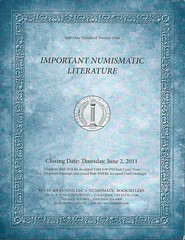 Kolbe & Fanning Numismatic Booksellers would like to remind people that their 121st sale closes this Thursday, June 2, 2011. It is one of the firm's largest and most diverse offerings in years. The 128-page, 1576-lot catalogue comprises a rather remarkable selection of interesting and elusive works on ancient, medieval and modern numismatics.
Kolbe & Fanning Numismatic Booksellers would like to remind people that their 121st sale closes this Thursday, June 2, 2011. It is one of the firm's largest and most diverse offerings in years. The 128-page, 1576-lot catalogue comprises a rather remarkable selection of interesting and elusive works on ancient, medieval and modern numismatics.
The sale starts off with Part 2 of the Alan Luedeking library, comprising over 700 lots, rich in rare and unusual works on Latin American numismatics. It is followed by nearly 200 lots from the Dr. Ira Rezak library, featuring a number of seldom-seen works on Russian coins and medals. The remaining 650 lots, the property of well over a dozen consignors, cover the numismatic spectrum. Many rare and unusual books, sale catalogues and ephemeral items on American numismatic topics are featured in this second half of the catalogue.
The catalogue is accessible free of charge on the Kolbe & Fanning website at www.numislit.com. Bids may be placed by mail, phone, fax or email:
Kolbe & Fanning Numismatic Booksellers
141 W. Johnstown Rd.
Gahanna, OH 43230
Phone: (614) 414-0855
Cell: (614) 256-8915
Fax: (614) 414-0860
email: df@numislit.com
Phone bids must be received by 6 p.m. Eastern Time on June 2. Bids may be left on voicemail or sent by fax or email until midnight. Mailed bids must be received by June 2 to be entered. Thank you, and we look forward to your participation!
NUMISMATIST ARTICLE HIGHLIGHTS NBS LIBRARY DONATIONS
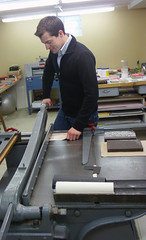 We are all familiar with the old saying "Don't judge a book by its cover." The Dwight N. Manley Numismatic Library staff politely disagree. In fact, we encourage ANA members to judge away!
We are all familiar with the old saying "Don't judge a book by its cover." The Dwight N. Manley Numismatic Library staff politely disagree. In fact, we encourage ANA members to judge away!
That is what we did last October, when Numismatic Bibliomania Society (NBS) board member Marc Ricard sent an e-mail announcing that the Society had donated $1,000 to the Library. The NBS asked only that the money be used to fund a special Library project or resource.
The NBS is a nonprofit, educational organization founded in 1979 with a mission to support and pro-mote the use and collecting of numismatic literature. "We contribute to the ANA Library because, being the book lovers that we are, we cherish an organization that both cares for the books under its stewardship and generously shares them with others," author and NBS board member John W. Adams said. Keeping all this in mind, Library staff came up with the perfect project—restoring publications in the Frank J. Katen Rare Book Room that are in poor condition.
During the past two years, the ANA has worked hard to improve the overall care and quality of material in the Frank J. Katen Rare Book Room. The staff and Library committee created a policy delineating what items should be stored there and what should be returned to the general collection for circulation.
We have made efforts to purchase historically significant numismatic literature, such as a vintage copy of the 19th-century journal Numisma and the first book dedicated to American coins, An Historical Account of American Coinage. We also recently finished packaging all 19th-century auction catalogs in acid- free envelopes to organize and better preserve them. In an effort to address overcrowding, we created a separate room for signed books and other items (more on that in coming months).
Restoration is an ongoing project in the Rare Book Room. As funding becomes available, we review the condition of books in the collection and flag them for restoration, a process that can range from a simple fix to more extensive measures.
Library staff worked with Rahm Bookbinding in Colorado Springs to assess needs. In business for more than 100 years, three generations of the Rahm family have practiced the art of custom bookbinding. The company's services include antique restorations, leather binding, and page-by-page restoration. The NBS donation funded the repair or restoration of more than 30 books, including a 17th-century, four-volume set on ancient coinage and E.J. Atinelli's 1876 work Numisgraphics. The NBS donation ensures that these books will be in good condition for future generations and will be candidates for digitization in the coming years.
This year, the NBS also donated to the American Numismatic Society's Rare Book Room and provided a scholarship for a young numismatist to attend the ANA's annual Summer Seminar. "It appears that the ANA, the American Numismatic Society and the NBS are ‘keepers of the flame,' so to speak, and we have the privilege and the responsibility of preserving and promoting the numismatic literature hobby," NBS President Dan Hamelberg said. "As finances permit, we would certainly like to make this donation an annual event."
If you are interested in donating to the Library's book restoration project, please contact Library staff at 719-482-9821 or e-mail library@money.org.
THE NUMISMATIST AVAILABLE IN IPHONE/IPAD APPS
Members of the American Numismatic Association can download free applications that allow them to read The Numismatist on Apple's iPhone and iPad. Now you can read the hobby's premier monthly magazine anywhere, anytime…and get the best in numismatic education and entertainment.
Says Barbara J. Gregory, ¬editor-in-chief of The Numismatist, "We are very excited about making the popular digital edition of the magazine available to iPhone and iPad users. The introduction of this valuable, new member benefit shows the Association's commitment to improving services and keeping up with technology."
Obtaining the new applications is easy: simply go to www.apple.com/iphone/apps-for-iphone and select "Free Apps" from the menu in the righthand column. Type "Numismatist" in the search window in the top right corner of the page, and you will find two applications: "The Numismatist" (iPhone) and "The Numismatist HD" (iPad). Then follow Apple's download instructions.
The new apps deliver the full, rich experience iPhone and iPad users expect. Accessing the magazine is just as easy as it is online, with full search capabilities and archives. The app is for use only on Apple products; however, similar ¬applications for Android devices are on the horizon.
Anyone can download the free application, but only ANA members can read complete ¬issues of The Numismatist. Use your e-mail address (the one on record with the ANA) as your login, and your ANA member number (numerals only) as your password. (Note that your login and password for the online magazine do not work with the iPhone/iPad apps.) Those who share an e-mail address with a spouse or child who also is an ANA member must provide the Membership Department with a unique address. If you need to verify your e-mail address as it appears in ANA records, contact membersonly@money.org.
CENTRAL STATES CREATES FUND FOR GRANTS TO NUMISMATIC AUTHORS
During the recent Central States Numismatic Society convention in Rosemont, IL the board of Governors approved spending up to $20,000 annually to fund numismatic books through grants to authors. The actual process of applying and getting a grant is being worked on right now by Ray Lockwood, CSNS's Education Director and Steve Beida the CSNS Legal Advisor. Hopefully the process will be set up soon. It is our intention to make grants yearly. I think that the grants will be in the $5000 range so that we can give out three or four a year...but again that detail is still being decided.
For more information on CSNS, see: www.centralstates.info
KOLBE & FANNING JUNE 2, 2011 SALE REMINDER
ALL BIDS MUST BE RECEIVED BY MIDNIGHT JUNE 2, 2011
REFER TO THE SALE CATALOGUE FOR DETAILS
THANK YOU IN ADVANCE FOR YOUR PARTICIPATION
Catalogue Available at Our Web Site: www.numislit.com
Printed Catalogues $10.00
KOLBE & FANNING NUMISMATIC BOOKSELLERS
141 W JOHNSTOWN ROAD, GAHANNA OH 43230-2700
(614) 414-0855 • df@numislit.com • GFK@numislit.com
ERIC NEWMAN PRESENTED WITH GOLD MEDAL HONORING HIS 100TH YEAR
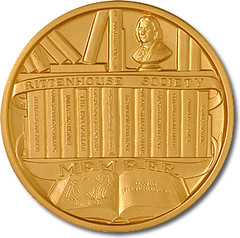

At the last Rittenhouse Society meeting at the 2010 Boston ANA Convention, Joel Orsoz proposed a medal be issued by the Society to member Eric Newman on his 100th anniversary. The proposal was met with unanimous approval by all in attendance. Dave Bowers stated it should be a gold medal and that I should oversee having the medal made.
Since the organization has no treasury the members assessed themselves an amount to pay for the sculptor's models and having the dies made. Medallic Art Company cut the dies and struck the medal.
The medal bears the portrait of Eric on the obverse between symbols of a quill pen and a lamp of knowledge, symbolic of the numismatic knowledge he has provided to the numismatic field. The reverse bears the names on the spines of the 13 books Eric has written. These are shown on two shelves with a tiny bust of David Rittenhouse on the top shelf and an image of Rittenhouse on an open book in the medal's exergue. The Rittenhouse Society, an informal group of numismatists created fifty years ago, was named after Rittenhouse, the first director of the U.S. Mint.
The medal is the creation of sculptor Luigi Badia, among whose work is the Carnegie Hero Fund Medal bearing the portrait of Andrew Carnegie. The reverse was designed by Joel Iskowitz, an artist of more than a dozen coins and medals, both for the U.S. Mint and private commissions.
The Newman family chose the reverse theme of Eric's 13 books. After a frantic search for someone among Rittenhouse Society members who could furnish all 13 books by Newman, the search ended with your editor, Wayne Homren, who sent all 13 to the artist to be modeled for the reverse design.
In names of books on the reverse there is a dollar sign in "Dollar $ign History" -- adding a touch of charm -- and the name "Early Paper Money of America" is in script like on the spine of the actual book. The details in the face of David Rittenhouse in the small statue on the top shelf reverse are distinctive even in such small size.
The presentation of the gold medal to Eric Newman took place at the Pierre Hotel in New York City at 1pm today, Sunday May 29th. In attendance were his wife, Evelyn, his daughter Linda Schapiro and son Andy Newman, and several of his grandchildren and great-grandchildren, all of whom had assembled in New York City for a weekend of celebrations of Eric's centennial day. John Kraljevich, Scott Rubin and Dick Johnson represented the Rittenhouse Society. In making the presentation Johnson stated:
"Eric, you have left an astounding legacy of your writing -- your numismatic books and articles -- that will last for decades, perhaps, centuries for the benefit of future numismatists. The medal we present to you today on your centennial year will last for centuries, perhaps millenniums or eons. You will long be remembered for the great numismatist you are. On behalf of the Rittenhouse Society I present to you this gold medal bearing your portrait and the 13 books that bear your name. Congratulations and continued long life."
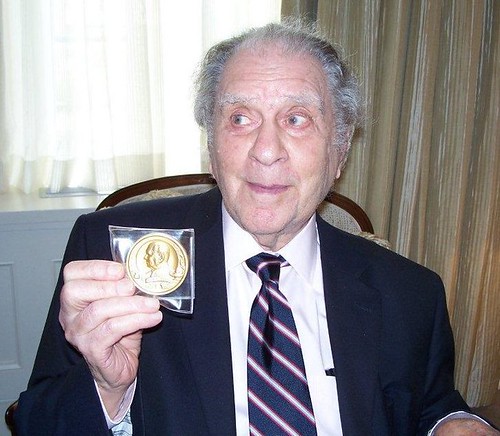
Description of the medal:
Size 2 3/8-inch (60.75 millimeters)
Composition: gold vermeil
Finish: uniform satin finish
Weight: 5.01 troy ounces
Artists:
Obverse designed and modeled by Luigi Badia
Reverse designed by Joel Iskowitz, modeled by Luigi Badia
Mounting: Cherry wood window top case.
Dick adds:
We are making available silver and bronze examples of the Newman medal at cost for those who would like their own permanent memento honoring one of America's greatest numismatists. For more information contact:
Dick Johnson
Rittenhouse Medal Chairman
dick.johnson@snet.net
NUMISMATISTS SHOWER CENTARIAN ERIC NEWMAN WITH BIRTHDAY WISHES
We found a Hallmark shop, figuring that was our best bet, but it was early and they weren't open yet. We went into a nearby dollar store instead. We found a number of things for ourselves and when my son caught me smiling in the aisle he asked me what was so funny. I'd spotted a party balloon section and toyed with the idea of mailing Eric a helium balloon in a box. I laughed when I envisioned my box levitating in the middle of Eric's living room, freaking everyone out.
The store had a card section, too. I found one that mentioned money and thought that might be just as appropriate. The cover inscription read: "In your heart of hearts, deep down inside, you know there's no money inside this card." Inside it said: But you still had to look, didn't you? Happy Birthday"
I added the word "Colonial" above "Money" with a pen before sealing the envelope. I realized later how appropriate it was that I'd bought it in a dollar store - one of Eric's early and important research topics was the origin of the dollar sign, which is part of the design of his medal.
Several others have sent Eric their wishes, and here are some I've seen floating around in emails this week. -Editor
Harvey G. Stack writes:
Last week's issue was great, the Eric Newman tribute is wonderful, and as one of the oldest dealers around, I am happy he made the mark of 100. I guess his next goal will be 110 or knowing Eric he probably will set his mark on 120 or more.
I met Eric some 70 years ago when he would visit our shop in New York, and at the age 13 for me then, he was as helpful with my learning of numismatics as any of my teachers.
He loved to talk coins, help with cataloging and enjoyed in those early visits to be with the members of the Stack Family, as he always said that we uncovered many collections he wanted to see, and wanted as he always did to develop numismatics as an art more than a trade.
I therefore want to join all those you quoted and heard from to wish him a very HAPPY BIRTHDAY and to continue to do what he has always done, make numismatics a hobby we can all be proud to be part of.
Ray Williams wrote:
Today marks the 100th Birthday for Eric Newman! And he is as active as ever in numismatic research! To reach this age is a big accomplishment, but to be continuing to do research, write and assist other authors is just amazing! I firmly believe his passion for our hobby has kept him young all these years.
Roger Moore wrote:
I think his willingness to help others in numismatic projects is a hallmark of Eric Newman. The selfish hoarding of images and data that occurred in others of his era (and in some of this era) is the opposite of his operational approach. I think that is one of the key reasons he is so respected and loved - of course there IS also the little matter of all his ground breaking research!! ;-) I hope he continues to contribute to numismatic research for years to come.
Mike Packard wrote:
Congratulations on reaching your 100th birthday. It is another highlight in a long list of personal accomplishments. We are happy that you are well and continuing your numismatic research. You have provided us with a lifetime of insights and research which have made our collecting more interesting, more rewarding, and more enjoyable. Too often we take others efforts for granted and do not recognize how much their efforts have contributed to our own enjoyment of the hobby. I would like to thank you for all your efforts. You are one of the giants on whose shoulders so many of us stand. Thank you for all you have done, and thank you in advance for your continued efforts that will expand the enjoyment of the hobby for us all.
Dave Bowers writes:
From all of your fine friends in the RITTENHOUSE SOCIETY, warm wishes and love to you on your centenary. You have enriched all of our lives and those around you in other venues. Here is wishing you many more happy years.
Joel Orosz wrote:
You are not only the Nestor of numismatic scholarship, you are the bester Nestor we've ever had! Hats off to you upon the completion the completion of your tenth decade, and all good wishes for many more successful projects during your eleventh!
Roger Burdette writes:
Enjoy the next 100 as much as the last! Thank you again for all your encouragement!
Ron Guth wrote:
Happy Birthday, Eric. You inspire us all to live long and, more importantly, to live well!
Dave Lange wrote:
This should be a national holiday for all numismatists!
John Kraljevich wrote:
A Birthday Poem
America's numismatist plenipotentiary
after decades of research evidentiary
has finally reached his first century
He inspires the young
by his work on the bung
and its inclusion in the literary dictionary
Eric -- you're living proof that a great man can still be one of the guys. Thank you not just for your decades of splendid, game-changing numismatic research, but for being a gentleman, a friend, and a generous soul. I admire your humor, your perspective, and your endless dedication to whatever you pursue.
I will raise a glass of something from a St. Louis brewery in your honor tonight, with fond sentiments and wishes.
Ed Reiter wrote:
Eric is, indeed, The Fantastic 1804 Scholar.
THE ONE-HUNDRED-YEAR-OLD NUMISMATISTS CLUB
Pete Smith writes:
On the morning of August 7, 1998, I had breakfast in a hotel in Portland Oregon. I believe other NBS board members were present. In walked Robert and Marjorie Hendershott. I greeted Bob and wished him a happy 100th birthday. He lived until March 22, 2005.
At one time Robert Hepworth Lloyd was the oldest ANA member, the one with the longest membership, or both. He lived from May 18, 1906, to October 10, 2009.
I never met Nellie Tayloe Ross. She lived from November 29, 1876, until December 19, 1977.
David Gladfelter writes:
Two I can think of are William S. Dewey, P.E. (1905-2006) and Robert L. Hendershott (1898-2005) Both were not only numismatists, but numismatic writers as well.
Bill had a long numismatic career. He was the ANA Librarian during the 1930s at a time when the library was kept in the librarian's home. In 1940, Bill was a member of a seven man committee that compiled and published the 194-page comprehensive index to the first 51 volumes of ANA's periodical, The Numismatist. The committee consulted Sydney P. Noe, compiler of the 1917 index to The American Journal of Numismatics, and its index followed Noe's format.
Bill formed an impressive collection of medals of Admiral George Dewey, a distant relative, and published a catalog of them in The Numismatist along with many other articles. In 1984 he received a first place literary award from the Society of Paper Money Collectors for his four part study of the widely collected railroad scrip issued by Samuel A. and William S. Torrey of Manchester Township, New Jersey. Bill received a presidential award from ANA in 1994 and a Krause Numismatic Ambassador award in 1987. In addition to his articles,
Bill published two books about the history and numismatic issues of businesses in Ocean County, New Jersey, where he resided in his later years. I had the pleasure of working with Bill on an article about the paper scrip of the Bergen Iron Works, published in 1998. SPMC awarded us a pair of glass mugs for that article, which you see us breaking in with a refreshing drink of sparkling cider (the alcohol free kind) at his home.
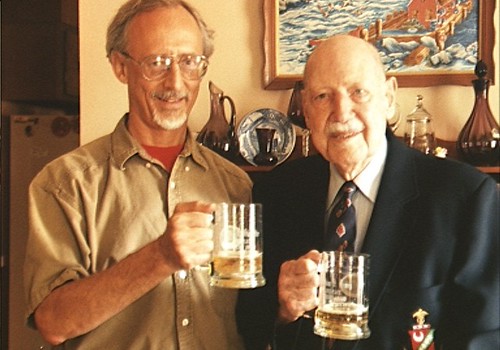
 I was introduced to Robert Hendershott by John Wilson at the ANA convention in New York in 2002. He was very frail by then, but offered to autograph my copy of his book, The 1904 St. Louis World's Fair, which he had actually attended as a young boy. Robert had published this 365-page book in 1994 at the age of 96. The foreword was written by none other than that young kid, Eric P. Newman. Since Robert had already autographed the book for a prior owner, Jim Marino, I declined his offer, but did enjoy a brief visit with him in the relaxed atmosphere of the ANA life members room.
I was introduced to Robert Hendershott by John Wilson at the ANA convention in New York in 2002. He was very frail by then, but offered to autograph my copy of his book, The 1904 St. Louis World's Fair, which he had actually attended as a young boy. Robert had published this 365-page book in 1994 at the age of 96. The foreword was written by none other than that young kid, Eric P. Newman. Since Robert had already autographed the book for a prior owner, Jim Marino, I declined his offer, but did enjoy a brief visit with him in the relaxed atmosphere of the ANA life members room.
George Cuhaj writes:
Edward Gans (1887-1991), who was a partner with Henry Grunthal in the auction firm of Grunthal & Gans, and Numismatic Fine Arts (1947-1961) reached above the age of 100 in 1987, and was presented a citation by the American Numismatic Society when he reached that milestone. There is some nice info on Gans on the Leo Baeck institute site. See: www.archive.org/details/eduardgansfamily00reel02 . Henry Grunthal lived to the age of 95 or 96 (1905-2001).
Dave Hirt writes:
I enjoyed this week's issue as usual. The tributes to Eric Newman were great. He really is an amazing man. I remember at an ANA convention, a group of us including Eric were talking, and he remarked that when he had arrived there was a problem with his hotel reservation, and at first, there was no room for him. Someone said, Well, "...you could have roomed with John Ford." Everyone got a laugh, and even Eric smiled.
On the 100 year old collectors, John was probably thinking of George Marlier, and Edward Gans. I know of one other, ANA member Dr Jesse Green who died at 103 years. He picture is in the Sept 1920 Numismatist on page 402.
George Cuhaj adds:
I think next year Catherine Bullowa will be 100 ! She still had a table at the NYINC, and CICF this year, and perhaps Chicago's ANA...this summer.
Plated 1907 Stickney Chapman Catalog
MORE ON BILL MCDONALD
I am greatly saddened to hear of the passing of Bill McDonald. Bill was first and foremost a gentleman. He was also a great numismatic scholar, and one of the greatest collectors of his time. He assembled world class collections in the fields of Canadian Chartered banknotes, Canadian Merchant scrip, Foreign private banknotes and books on Banking history. I feel fortunate that I was able to sell Bill many wonderful items in all these areas in the 1980's and 90's when he was still actively collecting them.
As well as the organizations already mentioned by others, Bill was also a life member and strong supporter of the International Bank Note Society, serving a number of terms on the Board of Directors in the 1960's, 70's and I believe the 80's. What I most treasured about my relationship with Bill was his generosity and friendship. He would always stop by my bourse table at any show we were both at, say hello and have a conversation. He also was always willing to answer any numismatic question I had for him (there were many) to the best of his ability. His willingness to share his vast knowledge will always be treasured.
Bill continued to regularly attend the major coin shows in the Toronto area and most CNA convention until a few years ago when his health began to fail. Bill also was the co-chairman and organizational giant behind the Iterpam Convention held in Toronto in 1981. It was a wonderful International Paper Money extravaganza that has never been equaled. My sympathies are extended to his lovely wife Gwen, who so often accompanied Bill on his numismatic travels. Bill will be greatly missed! May he rest in peace.
Joe Boling writes:
I built my first numismatic exhibit (of Japanese coins and paper) in late 1973. I test-drove it at the Everett Coin Club's show in November, and then took it to the Vancouver Numismatic Society's show in spring 1974, where it won best-of-show. Bill McDonald was on the floor and looked me up to praise the exhibit and encourage me to keep exhibiting. As a collector of fewer than ten years and a novice exhibitor, his words meant a lot to me. I can't say my trajectory as an exhibitor and judge was launched from there, but it certainly got a nudge.
A few years later, I believe it was at the Atlanta ANA in 1977, he was bringing book inventory to the show (as Marlcourt Books) and was forced to hire a customs broker to get his stock into the country. He was livid - it cost him several hundred dollars, probably more than the books were worth.
I have other stories that I associate with him, but at this distance it's hard to remember which involved him and which involved Jack Veffer - they probably were co-conspirators.
To read the earlier E-Sylum article, see: William H. McDonald, 1924-2011 (www.coinbooks.org/esylum_v14n21a04.html)
HARVEY AND LAWRENCE STACK REJOIN STACKS-BOWERS


Harvey and Lawrence Stack

Stack's Bowers Galleries announced today that Harvey G. Stack and his son Lawrence R. Stack are coming out of retirement to rejoin the firm now known as Stack's Bowers Galleries, following a two-year hiatus from professional numismatics. Stack's Bowers also announced that Harvey Stack, considered to be a numismatic legend, will join with two more titans of the industry, Q. David Bowers, Stack's Bowers chairman emeritus, and David Hall, president of Collectors Universe, to catalog the ultra high-end Rarities Night Auction, the feature official auction event presented by Stack's Bowers Galleries at the ANA World's Fair of Money in Chicago this August.
"The value of this addition of Harvey and Larry Stack to the Stack's Bowers team is simply beyond measure," said Greg Roberts, CEO of parent corporation Spectrum Group International, Inc. "Harvey's lifetime of experience has greatly influenced this industry, and he brings with him a remarkable sense of integrity and reliability that further enhance his extraordinary skills. And like his father, Larry was raised in numismatics and learned from the masters of the field, building his own reputation as a specialized leader in the industry."
Harvey is the son of Morton M. Stack and nephew of Joseph B. Stack, who formed Stack's rare coin business in 1933, where Harvey worked as a full-time staff member for 62 years, from 1947 until his retirement in 2009 as chief manager of business affairs. During those six decades, Harvey personally conducted more auction sales than anyone in the numismatic industry, and he appraised and cataloged countless numismatic rarities and was responsible for the sale of some of the most spectacular collections in history, such as the Anderson Dupont Collection, the Davis-Graves Collection, and the Harold S. Bareford Collection.
A member of the American Numismatic Association (ANA) for more than half a century, Harvey has been a staunch supporter of the organization through the years, including contributing to the building of its Colorado Springs headquarters, which houses the Stack's Gallery endowed by the family and bearing its name. He was also directly involved with the first ANA Grading Guide and has received the Association's Medal of Merit, and in 1997 he was named the ANA Numismatist of the Year in recognition of 50 years of service to the coin collecting hobby.
Harvey served as president of the Professional Numismatists Guild (PNG) from 1990-91, after serving on its board for more than 10 years, and he effectively defended PNG and the industry from proposed Federal Trade Commission regulations which he felt were inappropriate for responsible professional numismatists. He was honored by his peers with the coveted PNG founders' award in 1993 and again in 1998 for an unprecedented second time. In addition, Harvey is a Fellow of the American Numismatic Society and an active member of the International Association of Professional Numismatists and Royal Numismatic Society, and he serves as a lifetime member of the prestigious Smithsonian Society.
For more information about Stack's Bowers Galleries, call 800.458.4646 or visit www.stacksbowers.com. For media inquiries, call Kris Briggs, marketing manager.
NORTHWEST TERRITORIAL MINT ACQUIRES GRACO AWARDS
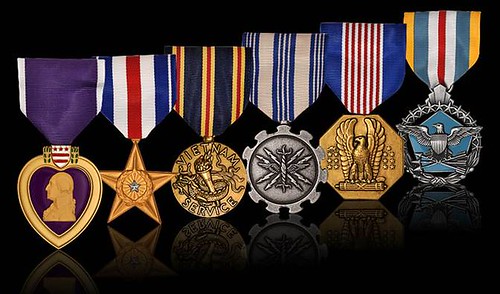
Northwest Territorial Mint, a primary source of US military challenge coins, has acquired Graco Awards, a prime contractor of medals and service ribbons for the Defense Supply Center and almost every government agency.
The combined entity will now employ more than 300 people at seven locations across the United States. The acquisition of Graco Awards will also add an additional 30,000 square feet of production facilities to Northwest Territorial Mint's 150,000-square-foot manufacturing capacity.
Graco Awards' superior product quality and customer service, on-time delivery, dependability, and accuracy was recognized with a Vendor Excellence Award by the Defense Logistics Agency, which manages more than five million consumable items for the U.S. military.
With this acquisition, Northwest Territorial Mint significantly increases the depth and span of its sales coverage in the market by welcoming more than 60 highly-trained employees from Graco – individuals who know the marketplace and products, and who already have existing client relationships.
The Medal of Honor, the Silver Star, and the Purple Heart are among the significant American military awards entrusted to Graco Awards to manufacture. That level of prestige fits well with Northwest Territorial Mint and its Medallic Art division, each with a distinguished history of designing and minting important medals and awards.
About Northwest Territorial Mint:
Since 1984, Northwest Territorial Mint has specialized in designing and creating custom coins, medallions, and related items of the highest craftsmanship for individuals and institutions worldwide. Its coins have been handed out by the Commander in Chief, the Secretary of Defense, the Chairman of the Joint Chiefs of Staff, and many other high-ranking military officers and elected officials. Its commemorative coins are available at Navy, Army, Air Force, and Coast Guard exchanges and its online store, and it is licensed to create and sell for many iconic American organizations, including Boy Scouts of America, Harley-Davidson, and the National Rifle Association. Its Medallic Art Company division was acquired in 2009 and dates to 1903. Through the years, the company has reproduced bas relief work of some of the most famous American sculptors, as well as many of the important medals and awards in the United States, including the Pulitzer Prize, Congressional Medal of Honor, National Medal of Science, President‘s Medal for Freedom, the Newbery and Caldecott Medals, and the inaugural medals for 11 U.S. presidents. Medallic Art Company is co-located in Dayton, NV with Northwest Territorial Mint, which also has facilities in Federal Way, WA; Auburn, WA; Green Bay, WI; Alexandria, VA; and the Pentagon.
About Graco Awards:
Graco Awards is one of the nation's premier military medals manufacturers, producing some of the nation's most important awards, including the Medal of Honor, the Silver Star, and the Purple Heart. Its awards are of the highest quality and are made in the USA. Established in 1981, Graco works with almost every government agency, though some Graco medals for specific secret agencies and will never be seen in public.
To visit the Northwest Territorial Mint web site, see: www.nwtmint.com
DICK JOHNSON ON PHALERISTICS AND MEDAL TERMINOLOGY
Because of the royal distinctions of some orders – often the most distinct, elaborate, jewel encrusted medallic items worn by members of a highly select group – these are the most important, the top of the pyramid.
There are also orders of chivalry which go back in history to knights in armor protecting fair maidens. An "order" is both the name of the group as well as the medallic item to be worn (and these include collars worn over the head with an elaborate pendant medal to rest on the chest). These orders were often made by royal jewelers and had separate classes, sometimes as many as twelve classes from the king down to the lowest knight, each class made of more important size, composition or jewels than those of lower class. [We have none of these in America, we are more democratic.]
Below orders are the decorations – medallic items awarded for gallantry or meritorious service . These can be elaborate, but not as important as orders, and are always distinguished by shape, never round. Because: the medals of a class below decorations are usually round. An example would be campaign medals – those medals hung from a ribbon drape awarded to all who participated in a military or naval campaign.
Since all the medals described above are intended to be worn, there are prescribed rules for the proper wearing of these medallic items on uniforms, formal and civilian attire. Phalerists have come up with a term for all medals that are not worn – table medals – medals that just lie on the … you get the idea.
Resources.
The source for the best terms in the field are, obviously, from the Institute of Heraldry. They are very knowledgeable, and the specification sheets for individual medals are precise and identify the proper term for every part.
The best printed glossary in the field was compiled by Alexander John Laslo (1940-2004) who was editor of the official publication of the Orders, Medals Society of America. Under his editorial guidance the journal transformed from black-and-white to full color.
Laslo (Alexander J.) A Glossary of Terms Used in Phaleristics – The Science, Study, and Collecting of The Insignia of Orders, Decorations and Medals. Albuquerque NM: Dorado Publishing (1995) 58 pages, illustrated.
QUERY: WOODWARD AND LOTHROP DEPARTMENT STORE COIN SHOP
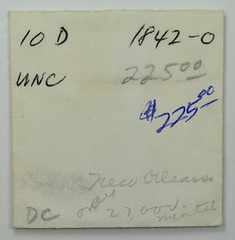

GreatCollections is proud to auction a newly discovered Mint State 1842-O Eagle, which ranks among the finest known.
The coin was originally purchased in the early 1960s for $225 at Woodward and Lothrop, a major department store in Washington, DC. The original envelope, with the dealer's handwriting notes "only 27,000 minted" as well as the purchase price will accompany the coin when it is sold by auction on June 26, 2011.
"Out of the estimated survivors, this ranks as one of the finest. PCGS has graded just three examples as Mint State, and this is the lone Mint State currently approved by CAC," said Ian Russell, president of GreatCollections.
Russell continues, "Aside from the phenomenal appearance and quality, what adds interest to the coin is the pedigree back to the early 1960s, where it was purchased at Woodward and Lothrop for the then-pricey sum of $225. This was the jewel in the collection. Relatives of the late owner can remember family stories about this rare $10 piece, without knowing exactly how rare or valuable it was.
"One doesn't really think of going today to Bloomingdale's or Macy's to buy rare coins, though back in the 1960s, select major department stores had a rare coin counter, where collectors could buy and sell coins."
To read the complete article, see: GreatCollections to Auction 1842-O $10 Gold Eagle, Among Finest Known (www.coinnews.net/author/great-collections/)
A HANDY GUIDE IN THESE VOLATILE TIMES.
ARTICLE: ANOTHER 1794 STARRED REVERSE LARGE CENT DISCOVERED?
Wolfe discovered the 1794 large cent with a starred reverse in a collection that was consigned for sale.
"Although the U.S. mint made many 1794 large cents, the starred reverse is a very rare variety and is highly sought after by collectors," Wolfe said. "No one knows how many of this variety were minted, but information on the Internet indicates that there are about 60 known to exist."
Because of the coin's condition, Wolfe was hesitant to place a value on it.
A search of coin-collecting sites on the Internet showed a wide range of values for the coin, with most close to $10,000 but some ranging as high as $80,000.
"I thought it was pretty unique, to find a rare variety like that in the ground," Wolfe said.
The rare coin was in a box with other types of coins presented to Wolfe.
"As I studied the coin, I realized what I was holding in my hands," he said.
His client was not aware of the coin's value.
"When he consigned his collection to me we had discussed the contents of his collection, and this rare coin was not mentioned," Wolfe said. "I contacted him and informed him of my find. He was totally amazed and happy. He did not know he had this prized coin in his collection."
To read the complete article, see: Rare 1794 coin to be auctioned Saturday (www.ldnews.com/lebanonnews/ci_18104567)
A rare coin worth one cent when it was minted fetched $5,500 at an auction in Lebanon County over the weekend.
The rare 1794 large cent with a starred reverse was sold to a Hummelstown coin dealer who had not immediately decided whether to sell it or keep it, according to auctioneer Russell Wolfe Jr.
Wolfe said the rare copper coin could have sold for more than $10,000 had it not been corroded from spending decades underground.
The seller, a Myerstown area man who found the coin with a metal detector, was said to be happy with the price.
Wolfe said the seller didn't know how rare the coin was until he consigned his collection for the sale.
To read the complete article, see: Rare penny fetches $5,500 at Lebanon auction (www.abc27.com/story/14698920/rare-penny-fetches-5500-at-lebanon-auction)
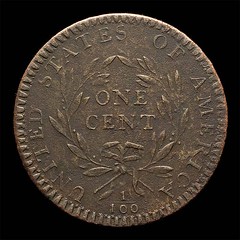 Among the most famous and popular of early federal coins is the 1794 cent variety featuring a circle of 94 tiny stars around its reverse border. Though partially hidden by the denticles which overlap them, these stars have captured the imaginations of coin collectors since this variety was discovered in 1876 by legendary dealer Henry Chapman. Since that time about 40 examples have come to light, the finest of these overall being the one plated in William C. Noyes' book United States Large Cents 1793-1814.
Among the most famous and popular of early federal coins is the 1794 cent variety featuring a circle of 94 tiny stars around its reverse border. Though partially hidden by the denticles which overlap them, these stars have captured the imaginations of coin collectors since this variety was discovered in 1876 by legendary dealer Henry Chapman. Since that time about 40 examples have come to light, the finest of these overall being the one plated in William C. Noyes' book United States Large Cents 1793-1814.
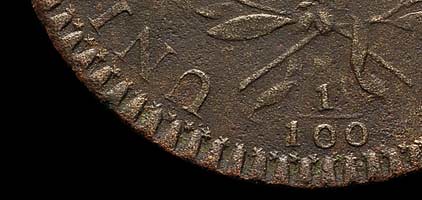
To read the complete article, see: NCS Certifies Newly Discovered Specimen of the Rare Starred Reverse Cent (www.ncscoin.com/news/viewarticle.aspx?IDArticle=1375)
S.S. CENTRAL AMERICA CASE COMING TO TRIAL
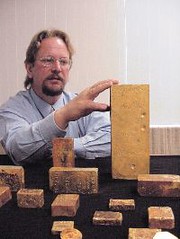
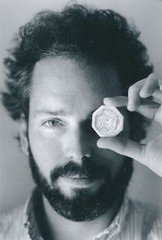
The proposal seemed preposterous: Tommy Thompson, an engineer and shipwreck-enthusiast, said he could find a steamer that had sunk in 1857 off the Carolina coast with 21 tons of gold in its hold.
Wealthy central Ohio men and women listened, and one by one anteed up money so Thompson's expedition could move forward. The chance that Thompson would find the ship was one in a million, they knew. On the other hand, he was so confident, so persuasive, so sure he could find it.
Still, perhaps no one was more surprised than those 161 investors when Thompson actually found the SS Central America in 1988 - 8,000 feet down - and eventually brought up a treasure-trove of gold coins and bars worth up to $400 million.
But as difficult as the search-and-recovery expedition was, unraveling who is entitled to the riches has been even more difficult. Twenty-three years later, investors have not seen a cent of profit, and crew members who claim they are owed part of the proceeds haven't received that, either.
A trial is scheduled in federal court late next month that could untangle some of the secrecy that has always surrounded the "gold ship."
In 1989, the outlook for investors was rosy. News stories quoted one expedition lawyer as saying investors could get $5 to $340 on the dollar. The original 161 investors contributed $12.7million to Recovery Limited, and a second group of 90 investors put up $9million for future exploration in 1990-91 under the name Columbus Exploration. Thompson was in charge of both companies.
Under the partnership, Thompson and other expedition leaders would get 40percent of the proceeds, and investors would get the remainder.
But lawsuits by companies that had insured the Central America were costly and lengthy, draining money from the company. In the late 1990s, a federal admiralty court in Norfolk, Va., awarded the insurance companies 7.8percent of the proceeds and Thompson's company the rest.
That allowed Thompson to sell the gold to California Gold Group for $52million in 2000, according to court testimony.
Where did the money go? Tigges said investors have not been given an accounting. Michael R. Szolosi, attorney for the technicians, said Thompson has never provided a list of the sale's proceeds.
Thompson's attorney, Richard Robol, said in a court proceeding on Feb. 4 that no money has been paid out to investors but that "the plan is ultimately to make payments."
Robol said that Thompson lives and works mostly in Florida, developing innovative techniques to explore the deep ocean for shipwrecks.
At least one investor, Columbus insurance broker Donald E. Garlikov, believes investors won't be paid unless the rest of the treasure can be brought up from the wreck. He believes that all the money made from the original recovered gold has been spent to repay the expedition's costs, for ongoing lawsuits and for payments to the insurance companies.
He said pending lawsuits are keeping Thompson from raising the money he needs to recover the rest of the gold, which some estimates put at 18 tons.
"My support for him has not changed," said Garlikov, who invested $300,000 originally and put up collateral at Thompson's request in the early 2000s when insurance companies tried to obtain a greater share of the proceeds.
Garlikov says Thompson and his crew are "honest, straight people" and not the "crooks" some have painted them.
To read the complete article, see:
Even recovered, ship's gold remains mystery
(www.dispatch.com/live/content/local_news/stories/2011/05/29/
even-recovered-ships-gold-remains-mystery.html)
NEW INFORMATION ON THE COREY'S OINTMENT COUNTERSTAMP
Recently (4/2011), two different references to "Corey's Ointment" have appeared online in Google Books. The countermark "TRY / COREY'S / OINTMENT" has been a numismatic mystery for a long time, and it still is, so it is nice to see digitized references to it finally appearing online. In the journal "Once a Week - New Series" (published in London), dated July - December 1872, there is mention of "Corey's Ointment" advertisements being seen painted everywhere along railway lines. The article is titled "QUACKS AND QUACKERY IN AMERICA", by John C. Dent. Corey's Ointment is mentioned on page 236, as follows:
In traveling by rail through the United States or Canada, it is next to impossible to look out of the window of the carriage without being enjoined to "Try Corey's Ointment". This injunction, or some other of a like nature, is rudely but distinctly painted on every fence, bridge, and large stone along the line of every trans-Atlantic railway on which it has been my destiny to travel.
Another reference appears in an advertisement published in the Canadian pharmaceutical journal, Volume 17, by the Canadian Pharmaceutical Association, 1883-1884. On page 20, the company Northrop & Lyman, Toronto, General Agents for and Dealers in PATENT MEDICINES, advertised their extensive list of patent medicines. The names of the various patent medicines are a fun read, and are sure to make you either laugh or cringe (or both). They include "Corey's Ointment" as one of their offerings. Some others are: "Dr. Thomas' Eclectric Oil", "Canadian Pain Destroyer", "Corey's Dysentery Remedy" (same issuer ???), "Elixir of Beef, Iron, and Wine", and many others.
In summary, we now know that Corey's Ointment was being advertised in print prior to 1872 (and probably earlier), and was still being sold as late as 1884 (and probably later). Earlier it had been assumed that this was a Civil War era token, since the latest dated coin with this countermark is 1861.
THE COIN COLLECTOR AND BOWERS' NICKELODEONS
I started dabbling with coins and if opportunity presented, I bought and sold coins. I was instrumental in organizing a coin club in Kewanee, Ill.
A fellow by the name of Ed Babka lived in Kewanee and owned and published The Antique Trader, which was by far the foremost publication for antiques. Ed had learned about the Lawrence brothers from Iowa who were publishing a nationally circulated coin paper called The Coin Collector. Ed felt it would be a complementary adjunct to his antique publication so bought the paper and brought its operation to Kewanee.
One day I happened into Ed in downtown Kewanee. I described to him a column that I thought would be of interest to his readers. He responded quickly, "Sounds like a great idea. Why don't you write it?" Well, why not? I called the column "Whatsit?" Anyone collecting coins usually soon acquires some pieces of which they know nothing but would like to find out about them. Starting with some items from my own collection, I put pictures in the column encouraging readers to identify and tell about the piece. Response to the column was greatly favorable and enthusiastic and was influential in expanding subscriptions.
Ed had been listing himself as editor of the paper but felt that not appropriate since he had made his mark in antiques. He asked me to be the editor. I was only to continue my column, write an editorial for each issue and respond to letters to the editor. I went to the people to whom I was responsible and asked them if I could accept. I explained that I thought I could fulfill all my responsibilities to them and still do the editor's job. They consented and one man even said that might be a means to keep me around longer than otherwise.
One day Ed spoke to me and said there was a man from Dayton, Ohio, who had a nickelodeon collection and he wanted to do an article on them for his antique paper. He added, "The man seems also to be interested in coins. Do you want to ride along?" I surely did! He had a Beechcraft Bonanza; a hot, single engine, low wing, V-tailed aircraft. I had a private pilot's license and had logged hundreds of hours in the air. I hoped he would let me fly his plane. He didn't. We left Kewanee on a bright, sunshiny morning and headed to Dayton. When we got there, there was a heavy overcast. Evidently Ed did not have an instrument rating or his plane was not properly equipped. In any case we did not go in IFR (Instrument Flight Rules). We started to circle the field. All of a sudden there was a break in the overcast. We could see the ground through a small hole. Ed immediately pushed the wheel forward and we dove straight down through the hole and pulled up under the overcast. We landed VFR (Visual Flight Rules).
The man with the nickelodeons met us. It was Q. David Bowers. That was the first time I met Dave Bowers. Dave was immediately typical Dave – the epitome of graciousness and the consummate host. Dave drove us to his home in Oakwood, a high-end residential suburb of Dayton. His large basement plus some of the first floor was covered with nickelodeons – obviously one of the, if not the, largest collection of nickelodeons in the world.
Now to complete the numismatic history. The Lawrence brothers were numismatic pioneers. I am not certain but I am quite sure The Coin Collector well predated Numismatic News and Coin World. I think it was the first coin paper with a national circulation. I seriously doubt that one-tenth of 1 percent of all those involved in numismatics today ever heard of either the Lawrence brothers or The Coin Collector. This information should not be lost and I am glad to be able to record it here.
Chet Krause began to publish a paper called Numismatic News in 1952 in Iola, Wis. Eventually, he purchased The Coin Collector and moved its operation to Iola. He was kind enough to invite me to come along with the paper. I still had something I wished to accomplish in my other profession so I declined.
I went on to join the staff of Paramount International Coin Corp., which at that time was purported to be the largest coin company in the world. David Bowers and Jim Ruddy had been president and treasurer, respectively. Jim made his mark with Photograde.
A few years later, Dave invited me to call auctions for his company, which I was most pleased to do, and called several auctions all over the nation for him.
Can anyone tell us more about The Coin Collector? Does anyone have any issues in their library? It was before my time and I'm not sure if I've ever seen a copy. -Editor
To read the complete article, see: Through the Clouds to Meet Bowers (www.numismaster.com/ta/numis/Article.jsp?ad=article&ArticleId=20674)
THE BOOK BAZARRE
NUMISMATIST ARTICLE DISCUSSES 1817 TEXAS JOLA COINS
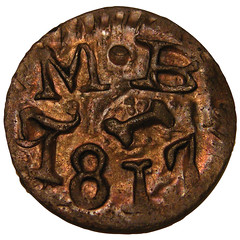

Numismatists who study the U.S. colonial coin series credit the small, copper ½-real pieces known as the jolas of New Spain (Texas) as the first appearance of the Lone Star symbol for Texas. These jolas were struck in 1817 and 1818.
The 1818 jolas are exceedingly rare in their own right, but the recent discovery of six examples of 1817 jolas bearing the Lone Star symbol sheds new light on this short-lived, but historically significant series. The first widely published images of the 1817 coins appeared in James Bevill's 2009 book, ¬Paper Republic: The Struggle for Money, Credit and Independence in the Republic of Texas.
Minted in San Antonio de Béxar in 1817-18, ¬jolas are the only Spanish coins known to have been struck in what now is the United States. The Republic of Texas ¬existed as an independent ¬nation for 10 years, and its boundaries included parts of present-day Oklahoma, Kansas, New Mexico, Colorado and Wyoming. Texas ceased to be an independent nation in early 1846. Unlike the original 13 colonies, it had never been under British rule, having been settled under the flags of Spain and Mexico prior to winning independence during the violent Texas Revolution of 1835-36.
When jolas were struck for use in regional commerce, Texas was a northern province of Nueva España (New Spain).
In 1817 acting Spanish Governor Manuel Pardo received authorization from Mexico City to strike small copper coinage to facilitate commerce. He selected Manuel Barrera, a ¬local merchant and administrator, to produce 8,000 jolas. There is ¬irrefutable written evidence in the original Béxar archives that the Barrera coins were released into circulation in San Fernando de Béxar on or about March 29, 1817.
Only six specimens of the 1817 jolas struck for circulation and bearing the Lone Star reverse are known today. Although mintage of 8,000 coins was authorized, it is not known how many were struck. All six measure 18mm in diameter, have the fraction rotated to the right, and weigh -between 1.3g and 1.6g. There is only one die variety, in which each coin exhibits a series of ridges on the periphery of the obverse. Curiously, no bar separates the numbers in the fractional denomination.
The 1817 jolas are so rare that they constitute a one-year type in a two-year series. If authenticated, they represent the first circulating coins struck in Texas, or in any of the former Spanish Territories (1810-21) or Mexican areas (1821-48) presently located in the United States. The little jolas, coined while Texas was still known as New Spain, left a lasting imprint of the Lone Star that became, and will forever be, a unique symbol of Texas.
1834 EDWIN FORREST PORTRAIT MEDAL
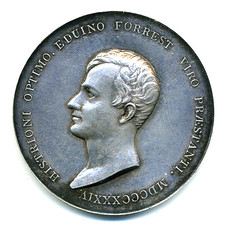

EDWIN FORREST PORTRAIT MEDAL, 1834. 42.8mm. Silver. (41.8 grams). C.C. Wright (Obv.) & C. Ingham, (Rev.) Proof-like About Uncirculated, lightly hairlined. Obverse with a bust of Forrest to the left surrounded by the legend: HISTRIONI OPTIMO. EDUINO FORREST. VIRO PRAESTANTI. MDCCCXXXIV. The reverse shows Melpomene, the Muse of Tragedy seated, holding in one hand a wreath, the other holding a dagger, and resting on her lap. A mask rests beside her. Legend: GREAT IN MOUTHS OF WISEST CENSURE. Original case of issue.
Edwin Forrest (1806-72) is considered the first great native born actor of the American theater. He was celebrated in his Shakespearan roles as one of the century's great tragedians. His exuberant acting style carried over into his personal behavior and he conducted a famous feud with his rival, the English actor, William Charles Macready. The rivalry culminated in the Astor Place riot (1849) in New York City where a mob of several thousand anti-Macready/anti-British Forrest partisans protested Macready's performance and did battle with 300 policemen and the militia. The result was that thirty-one of the rioters were killed and many more were injured.
Life of Edwin Forrest By William Rounseville Alger: 2 struck in gold; 26 in silver.
For more information, see: Presidential Coin & Antique Company, Inc. (inauguralmedals.com)
NOTES FROM E-SYLUM READERS: MAY 29, 2011
Author Robert Duphorne Has Passed
Numismatic author Robert Duphorne's granddaughter Bambi writes:
I just found your article about the book Robert Duphorne on Bust or Cap Quarters. Robert was my grandfather and that book was something he took pride in no matter what anyone said. He passed away May 21 2011 and all his knowledge and proof of the different varieties are in that book. I thank you for the kind words in your article about my grandfather.
Respectfully,
Bambi, Robert's sidekick in coin collecting
And granddaughter
Members of the John Reich Collectors Society receive the group's quarterly publication, the John Reich Journal. I picked up my copy on my visit home last weekend. One of the featured articles is "Robert Duphorne and the 'Other' Bust Quarter Book." by Louis Scuderi. The eight-page article is a trove of information on this relatively obscure title. I've had a copy in my library for years but never knew much about the author, and I doubt that any bibliophile knew much until now.
To read the earlier E-Sylum article, see: ROBERT DUPHORNE AND THE 'OTHER' BUST QUARTER BOOK (www.coinbooks.org/esylum_v10n29a05.html)
Utah Allows Gold and Silver Coins
Stephen Pradier forwarded this link to an article about gold and silver coins becoming legal in Utah.
To read the complete article, see: Gold, silver coins to be legal currency in Utah (hosted.ap.org/dynamic/stories/U/US_BACK_TO_GOLD)
John Regitko of Toronto, Canada writes:
In the last E-Sylum, you gave credit, deservedly, to Darryl Atchison for editing the massive two-volume Canadian Numismatic Bibliography. The other person that deserves a lot of credit for getting it published is the person that laid it all out to make it eye appealing and easy to digest. That is none other than another E-Sylum subscriber, Paul Petch of Toronto, who also spent many hours to bring it to fruition.
Joe Boling On 'Mr. 888'
Joe Boling writes:
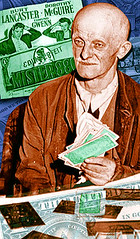 I have been on the road and burdened with projects since editing the new bond book announced in a late March e-Sylum - I have not had time to read the weekly offerings since than until now. So I have a few comments that may be so old as not to be relevant, but here goes.
I have been on the road and burdened with projects since editing the new bond book announced in a late March e-Sylum - I have not had time to read the weekly offerings since than until now. So I have a few comments that may be so old as not to be relevant, but here goes.
I enjoyed reading about ' Mr 880' in the 3 April issue. Yes, I've seen the movie and taped it off of cable a few years ago. It's available from Amazon.com in a PAL region 2-encoded format, titled "El Caso 880" (subtitled in Spanish). Wish I had a multi-region DVD player. He (Mr. 880) must have really made an impression on the Secret Service, because he was still being talked about by Mark Surrency when he taught the US counterfeit paper course at ANA summer seminar a few years ago.
In the 10 April issue, I saw why Mark Surrency was talking about the Mr. 880 case - Ken Hallenbeck asked him about it (but I don't recall seeing the actual note - certainly not a crude $1 note as described in the Daily News article).
To read the earlier E-Sylum article, see: MORE ON COUNTERFEITER "MR. 800" (www.coinbooks.org/esylum_v14n15a09.html)
Rats Or Kangaroos?
On the Rats of Tobruk medal, Joe Boling writes:
In the 10 April issue, I must say that the rat on the Tobruk medal looks more like a kangaroo, but what would you expect from a bunch of ANZACs?

To read the earlier E-Sylum article, see: THE RATS OF TOBRUK MEDAL (www.coinbooks.org/esylum_v14n15a08.html)
Joe Boling on Alan Grace
Joe Boling writes:
It was Alan, not Allan, Grace. I had only a few items bound by him - in each case a book (or set) that was in tatters from hard use or vandalism. The most extensive was an eight-volume set of Japanese books, two or three missing their spines. He repaired them (in half-leather), and built slipcases for all eight volumes. This set is now at the American Numismatic Association library (YOSHIDA Kensuke, Dai Nippon Kaheishi (A History of Japanese Currency), 1925-26 Coole J-47). Still with me are my forty-year-old Smith-Matravers and my first edition Munro, Coins of Japan. I am truly sorry to hear he is gone.
To read the earlier E-Sylum article, see: Bookbinder Allan Grace Has Passed (www.coinbooks.org/esylum_v14n16a03.html)
Harsh Lighting and Book Spines
Joe Boling writes:
That photo of the Fitzwilliam library room sure looks like it has extremely harsh lighting. Not good for exposed spines. Please tell me that those are not ordinary fluorescent bulbs.
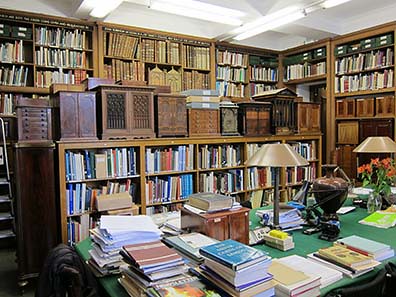
To read the earlier E-Sylum article, see: THE COIN CABINET IN THE FITZWILLIAM MUSEUM, CAMBRIDGE (www.coinbooks.org/esylum_v14n17a10.html)
On 'Greaseproof Paper'
Joe Boling writes:
Both articles (April 24tn May 1st ) about the Hackney hoard of US gold coins referred to "greaseproof paper" wrapping the coins. I'll wager that the paper was actually heavily greased so as to make it waterproof.
To read the earlier E-Sylum article, see: MORE ON THE U.S. GOLD COIN HOARD FOUND IN EAST LONDON (www.coinbooks.org/esylum_v14n18a10.html)
Daniel K E Ching's Rice Bowl Collection
Joe Boling writes:
I spent a day with Daniel K E Ching in 1976. More than any of his numismatic holdings, I remember his collection of rice bowls - all kinds of ceramic pieces. But we also spent time trading information about coins and notes, and three or four times during the day, he excitedly exclaimed "Isn't this fun?!" I'll not forget that enthusiasm.
To read the earlier E-Sylum article, see: MORE ON DANIEL K. E. CHING AND ARTHUR COOLE (www.coinbooks.org/esylum_v14n19a05.html)
Why Charge Print Subscribers for Online Access?
Joe Boling writes:
The last line of Scott Tappa's plug for the digital edition of World Coin News is the rub - "Please note: The digital subscription is a separate subscription from your print subscription." Why? Amos Press makes its online editions available to any print subscriber. So does ANA.
Joe also noted some issue formatting errors that slipped thorough. I'll work with our webmaster Bruce Perdue to correct the online archive. Thanks! -Editor
To read the earlier E-Sylum article, see: NOTES FROM E-SYLUM READERS: May 22, 2011 (www.coinbooks.org/esylum_v14n21a05.html)
THE BOOK BAZARRE
KEN BRESSETT ON THE E-SYLUM MASTHEAD COIN
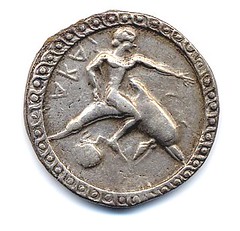
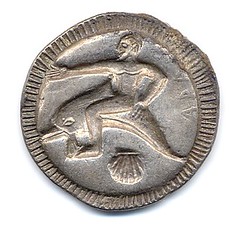
 I wonder if anyone has ever questioned what the ancient coin is that is only partially pictured on the E-Sylum masthead. Attached are images of both the obverse and reverse. It is an interesting coin for many reasons. The piece is a silver nomos from the city of Tarentum in Calabria, southern Italy. It was most likely minted in the period from 510 to 500 B.C. These pieces are about the size of a U.S. quarter, and weigh about 8 grams. The figure on the obverse is Taras-Phalanthos riding on the back of a dolphin. A scallop shell below the dolphin signifies the ocean. The inscription above reads TARAS, but is written retrograde as was a common custom at that time. On the reverse side, the entire design is repeated but is intaglio.
I wonder if anyone has ever questioned what the ancient coin is that is only partially pictured on the E-Sylum masthead. Attached are images of both the obverse and reverse. It is an interesting coin for many reasons. The piece is a silver nomos from the city of Tarentum in Calabria, southern Italy. It was most likely minted in the period from 510 to 500 B.C. These pieces are about the size of a U.S. quarter, and weigh about 8 grams. The figure on the obverse is Taras-Phalanthos riding on the back of a dolphin. A scallop shell below the dolphin signifies the ocean. The inscription above reads TARAS, but is written retrograde as was a common custom at that time. On the reverse side, the entire design is repeated but is intaglio.
The coins of Tarentum were part of a unique series of intaglio coins that were made in Magna Graecia during the period from about 550 to 480 B.C. They are exceptional for their original designs, distinctive borders, the use of writing to indicate the city name, and in that they were the first to use full designs on both sides. Also original was the technique of engraving one side intaglio and the other in relief. This was probably done to indicate a more or less uniform system of coinage that extended throughout southern Italy at that time. Legend has it that the Tarentum colonists were instructed by the Oracle of Delphi where to settle, and that Phalanthos made the trip from Greece to Italy with the aid of a friendly dolphin.
ATM REPAIRMAN ACCUSED OF LOADING FAKE MONEY
An employee of an ATM servicing company has been charged with swapping $200,000 in fake bills for real cash at machines in Daly City and San Francisco, a prosecutor said Thursday.
Kioskli was an employee of Diebold, which services ATMs for Bank of America. On July 4, Kioskli went to six bank branches in San Francisco and one in Daly City and stole about $200,000 by replacing cash in the machine trays with counterfeit or photocopied $20 bills, Wagstaffe said.
Kioskli used his work card key to access the ATMs and was captured on video at all seven locations, authorities said.
The next day, Kioskli "abandoned his wife and disappeared," Wagstaffe said. His wife reported him missing, and angry Bank of America customers contacted the bank to complain about the fake money, authorities said.
To read the complete article, see: ATM repairman accused of loading fake money (www.sfgate.com/cgi-bin/article.cgi?f=/c/a/2011/05/27/BANQ1JLBKP.DTL)
CAR ACCIDENT SPILLS COIN DEALER'S INVENTORY IN FLORIDA
A man's rare coin collection worth about $1 million was scattered along Florida's Interstate 95 when his car was involved in a rollover crash near New Smyrna Beach Thursday evening.
A Boca Raton couple was heading north to a coin show in Jacksonville when the back passenger-side tire blew out in Volusia County.
The SUV rolled, flipping as many as five times, police said. The rare collection went flying out of the car, spilling across the median.
The collector's wife's arm was fractured in the crash. The coin dealer's injuries were much worse. The man initially refused to leave the scene.
"He was in pain, but he was more worried about the money," Florida Highway Patrol Trooper Darryl Haywood Jr. said.
Rescue crews convinced the dealer, who they said has heart problems, that he needed to go to the hospital.
"The pain started setting in. I think his adrenaline kicked in when it first happened," Haywood said.
The man tapped into his network of collectors in the area to help recover the coins.
"Eight to nine people came out with metal detectors," Haywood said. "They tried to clean up the roadway and mess as much as possible."
Troopers stayed to help, too, and a tow truck driver found $46,000 in bills in the trees.
To read the complete article, see: Rare coin fortune found roadside (www.9news.com/news/sidetracks/200468/337/Rare-coin-fortune-found-roadside)

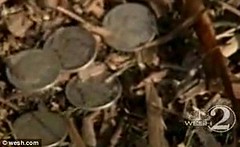
Demetri Cirillo, 47 and his wife Dawn, who live in Boca Raton were on their way to a show in Jacksonville when a back tire blew out in Volusia, Florida
The SUV rolled over, filling as many as five times, according to police. Much of the rare collection went flying out of the car, spilling across the median and into bushes by the side of the highway.
To read the complete article, see:
Flipping hell! Coin dealer's rare $1m collection scatters across highway when his SUV rolls over in crash
(www.dailymail.co.uk/news/article-1391721/Coin-dealers-1m-coin-
collection-scatters-highway-SUV-rolls-crash.html)
SRI LANKAN COINS FOR SAMBUDDHATVA JAYANTI
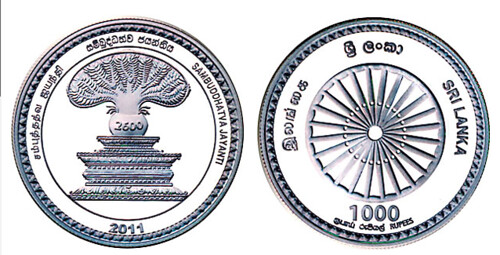
Please see the Sri Lanka Sunday Times, Plus Section - 2011 May 21 http://sundaytimes.lk/110522/Plus/plus_04.html This has images of the new Rs2000 NCLT coins issued
A longer article with line drawing of the Rs10/- coin to be put into circulation in few weeks is posted at
http://coins.lakdiva.org/cbsl/2011_2600sbj_coins.html
See more details in my web page for these coins at
http://coins.lakdiva.org/commemorative/2011_sambuddhatvajayanti2600_1000r.html
http://coins.lakdiva.org/commemorative/2011_sambuddhatvajayanti2600_10r.html
According to CBSL Press release the Rs 10/- coins will be only put into circulation in 2011 June
http://www.cbsl.gov.lk/pics_n_docs/latest_news/press_20110513e.pdf
To read the complete Sunday Times article, see: Coins for Sambuddhatva Jayanti (sundaytimes.lk/110522/Plus/plus_04.html)
POPE BENEDICT'S INTERNATIONAL SPACE STATION COIN
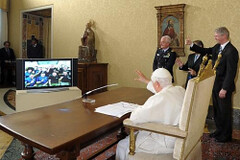 The Pope has made the first phone call to space: And, no, it wasn't to check on whether hundreds of thousands of people were travelling into the sky for today's predicted Rapture.
The Pope has made the first phone call to space: And, no, it wasn't to check on whether hundreds of thousands of people were travelling into the sky for today's predicted Rapture.
All joking aside, the chat between Pope Benedict XVI and the various astronauts on the International Space Station is the first such celestial conversation for the Holy See. Speaking via video link from the Vatican library, Benedict chatted with the astronauts for around twenty minutes—asking five questions and personally addressing Italian astronauts Roberto Vittori and Paolo Nespoli.
Benedict's questions often turned to the metaphorical aspects of the astronauts' lives on the space station--some 220 miles above the surface of the Earth and travelling at a speed of roughly 17,500 miles per hour.
"Space exploration is a fascinating scientific adventure. It's also an adventure of the human spirit, a powerful stimulus to reflect on the origins and the destiny of the universe and humanity," Benedict said.
"When we look up at the limitless heavens and meditate on the creation of it all, we are struck by the mysteries of His greatness. In the midst of your intense work and research, do you ever stop and reflect like this, perhaps even to say a prayer to the creator?" Vittori had the answer for that one: He did. But to emphasize the point, the astronaut floated up a silver coin that had been given to him by Benedict himself prior to the astronaut's trip into space. The coin depicts Michelangelo's Creation of Man—a neat artifact to bring along on a space journey, but not one that Vittori plans to hold on to for much longer.
The astronaut plans to give the coin back to the Vatican next week following the conclusion of Vittori's five-month jaunt onboard the space station. At that point, said coin will have traveled more than three million miles through space.
The Pope concluded his conversation with the astronauts by offering them an apostolic blessing.
To read the complete article, see: Pope Benedict Dials Up International Space Station (www.pcmag.com/article2/0,2817,2385712,00.asp)
DISCOVERY OF ‘HUGELY SIGNIFICANT' ROMAN COIN HOARD IN COLCHESTER, ENGLAND
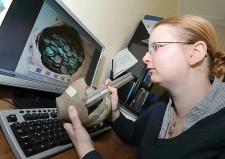 A HOARD of more than 1,200 Roman coins has been discovered during an archaeological dig in Colchester.
A HOARD of more than 1,200 Roman coins has been discovered during an archaeological dig in Colchester.
The find has been described as a "hugely significant national discovery which brings even more life and colour to Colchester's rich and fascinating history".
The coins, which date back nearly two millennia, were discovered inside a small grey-ware pot which had been buried in the ground at a development site off Mersea Road.
The discovery was made in March, but has been kept secret until today so the coins could be examined and sent to the British Museum.
Philip Crummy, director of the Colchester Archaeological Trust, said the hoard is made up of issues of nine Roman emperors ranging from Gallus (AD 251-3) to Victorinus (AD 269-271), with the latest coins in the hoard suggesting it may have been deposited in the early part of AD 271.
It is thought the hoard was buried for safe keeping but the owner either was unable to find it again or died sometime afterwards without revealing its location.
"The burial of coins seems to have been more common in periods of unrest or uncertainty," he said.
"The 270s was a difficult time in eastern England because of civil war in the Roman Empire and serious raiding along the coast by foreign peoples. This explains why the Hyderabad hoard is not the first hoard of this period to have been discovered in the Colchester area."
To read the complete article, see:
Colchester: Discovery of ‘hugely significant' Roman coin hoard
(www.eadt.co.uk/news/colchester_discovery_of_hugely_significant_
roman_coin_hoard_1_898791)
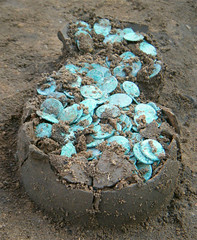 Last March The Colchester Archaeological Trust found a hidden stash of 1,247 Roman coins. They lay inside a small grey-ware pot which had been buried in the ground at a slight angle.
Last March The Colchester Archaeological Trust found a hidden stash of 1,247 Roman coins. They lay inside a small grey-ware pot which had been buried in the ground at a slight angle.
The coins are of a type known as antoniniani. The hoard is made up of issues of at least nine Roman emperors ranging from Gallus (251-3) to Victorinus (269-271). The latest coins in the hoard point to a date for its deposition in the early part of AD 271.
The antoninianus started life off as a silver coin issued in the early 3rd century but, by the time of the Hyderabad hoard, it had become very debased and ended up as a copper-alloy coin with a very thin silver coating. Severe inflation reduced its monetary value which is why later antoniniani are common finds on archaeological sites of the third quarter of the 3rd century. The Hyderabad hoard belongs to this period.
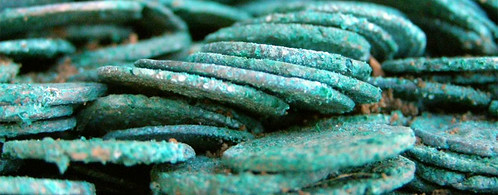
To read the complete article, see: Buried Savings Recovered After 1740 Years (www.pasthorizons.com/index.php/archives/05/2011/buried-savings-recovered-after-1740-years)
FEATURED WEB PAGE: BRAZILIAN TOKENS
This week's Featured Web Page is Alexandre O. F. De Barro's Brazilian Tokens site.This is the only web-site entirely dedicated to world tokens, and in particular, Brazilian tokens. I've been a token collector since 1960 and in 2009 I published the only catalogue specialised in Brazilian tokens, namely the General Catalogue of Brazilian Tokens. The catalogue is bilingual Portuguese-English and contains the repertory of all known types, including mining, hacienda, sugar mills, trade companies, restaurants, bars, transportation, casino, lepper tokens and many other modalities. Published in two large-format volumes the book is illustrated with more than a thousand colour photographs, gives market prices for the tokens in four degrees of preservation and a rarity index.
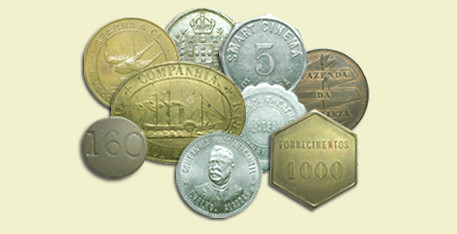
www.aofdebarros.com

